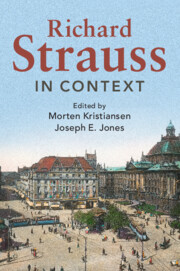Book contents
- Richard Strauss in Context
- Composers in Context
- Richard Strauss in Context
- Copyright page
- Contents
- Figures
- Notes on Contributors
- Preface
- Note on Translation
- Part I Family, Friends, and Collaborators
- Part II Career Stations
- Part III Cultural Engagement and Musical Life
- Part IV Professional and Musical Contexts
- Chapter 19 The Composer
- Chapter 20 The Conductor
- Chapter 21 The Orchestra
- Chapter 22 Program Music
- Chapter 23 Post-Wagnerian Opera
- Chapter 24 The Lied
- Part V In History
- Part VI Artifacts and Legacy
- Further Reading
- Appendix: Letters Bibliography
- Index
Chapter 21 - The Orchestra
from Part IV - Professional and Musical Contexts
Published online by Cambridge University Press: 08 October 2020
- Richard Strauss in Context
- Composers in Context
- Richard Strauss in Context
- Copyright page
- Contents
- Figures
- Notes on Contributors
- Preface
- Note on Translation
- Part I Family, Friends, and Collaborators
- Part II Career Stations
- Part III Cultural Engagement and Musical Life
- Part IV Professional and Musical Contexts
- Chapter 19 The Composer
- Chapter 20 The Conductor
- Chapter 21 The Orchestra
- Chapter 22 Program Music
- Chapter 23 Post-Wagnerian Opera
- Chapter 24 The Lied
- Part V In History
- Part VI Artifacts and Legacy
- Further Reading
- Appendix: Letters Bibliography
- Index
Summary
For Richard Strauss, the orchestra was his primary medium of expression, and his use of orchestral forces mirrors the growth and expansion of that ensemble in the late nineteenth century. Strauss’s earliest works call for a traditional double-wind orchestra, which reflects the conservative teachings of his father, Franz Strauss, but by the late 1880s, Richard’s tone poems require triple-wind ensembles with more brass, due to the influences of the Wagnerian Alexander Ritter. Strauss’s experiences as a conductor in Meiningen, Weimar, and elsewhere revealed the limitations of undersized orchestras and the growing practice of reinforcing those ensembles with additional instrumentalists for Wagnerian repertoire, especially including Strauss’s own works. Strauss’s revision of Hector Berlioz’s Treatise on Instrumentation (1905) also appears to have inspired a new generation of composers, who quickly adopted the Wagnerian orchestra in the years immediately after the Treatise appeared.
Keywords
- Type
- Chapter
- Information
- Richard Strauss in Context , pp. 191 - 199Publisher: Cambridge University PressPrint publication year: 2020

